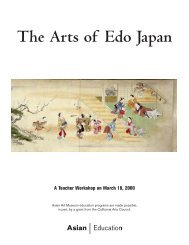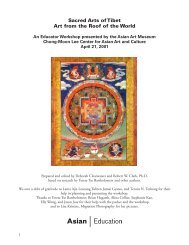Teacher Packet: Chinese Brushpainting (.pdf) - Asian Art Museum ...
Teacher Packet: Chinese Brushpainting (.pdf) - Asian Art Museum ...
Teacher Packet: Chinese Brushpainting (.pdf) - Asian Art Museum ...
Create successful ePaper yourself
Turn your PDF publications into a flip-book with our unique Google optimized e-Paper software.
Brushstrokes: Styles and Techniques of <strong>Chinese</strong> Painting<br />
forever, dwelling in the mountains, existing on dew and crushed jade. For the Confucians, Nature, as<br />
experienced in the mountain wilderness, exhibited the perfect li, or order of the universe, after which<br />
man should pattern his social existence. The <strong>Chinese</strong> words for “landscape,” shanshui hua, literally<br />
mean “mountain and water painting,” thus indicating the essential elements that make landscape the<br />
ultimate vehicle for artistic expression.<br />
Landscape also became the first genre in which artists fully explored the many techniques of<br />
brushpainting. Brushstrokes, the methods of using brush and ink developed in the practice of<br />
calligraphy, were the artists' means to their ends. The monumental landscapes of the Five Dynasties<br />
(906-960) and Northern Song (960-1127) periods initiate the exploration of various short dots and<br />
lines used in dense concentrations to build up a viable mountain of tough and eroded rocks, clinging<br />
vegetation, running streams, and forest trees. In other words, at this time painters used brushstrokes to<br />
recreate on paper the majesty and diversity of nature. They developed a rich variety of texture strokes<br />
including long and short hemp fiber strokes, cloud head strokes, raveled rope, and axe-cut strokes (see<br />
Chart C). The artist holds the brush at various angles to the paper and moves his wrist differently to<br />
produce each stroke. For instance, fine lines are produced by using the tip of the brush held vertically;<br />
the severed band stroke starts with a vertical or slightly oblique brush, turns, and ends with the<br />
brush held with its side to the paper. The rhythmic movement of the arm and wrist are part of the<br />
rhythmic vitality of a painting or a character. Wang Xizi, the 4th century calligrapher famous for his<br />
cursive script, enjoyed watching geese because "the movement of their turning necks seemed to him to<br />
resemble the movement of a man's wrist when he is handling the brush."<br />
In this landscape tradition, painters moved from a decoratively colorful and realistic form to one that<br />
is more restrained and conceptual. Although they still used color in light washes of blue-green and<br />
reddish-brown, painters conceived the pictures in black and white. In <strong>Chinese</strong> color theory, black<br />
contains all colors; thus theorists believe that people can conceive all colors in the various tones of ink.<br />
The poet-painter Su Dongpo was once criticized for painting bamboo with red ink, which the viewer<br />
said did not represent the natural aspect of the plant. When asked what color he should have used,<br />
Su's critic replied, "Black, of course."<br />
Invasions in the north by the Jin Tartars in the 12th century forced the Song dynasty to retreat to<br />
the south where a new court was established at Hangzhou in 1127. Under the Emperor Hui Zong<br />
the Imperial Painting Academy already was moving in the direction of closer views of nature, both in<br />
landscapes and in images of birds, flowers, and insects. The intent was to capture the vital life spirit of<br />
these subjects as well as an understanding of their true form, texture, and movement in space. Painters<br />
produced works in colors on silk in the meticulous gongbi style, outling the forms and applying<br />
washes of color smoothed out with water in many layers. Some also experimented with the looser<br />
mogu, or “boneless,” style. In this style the artist depicted a leaf or flower with only one or two<br />
strokes of wet ink or transparent color. This left the edges of leaves or petals free of restricting outlines,<br />
enhancing their lifelikeness. (For later examples of this method see slides 15 and 16.) The academic<br />
style of ink painting reflected the softer landscape of the southern regions, with its broad rivers, low<br />
hills, and misty atmosphere. Trees appear as well trimmed and trained garden specimens, with artfully<br />
bent trunks and sparse angular branches. Figures depicted in a crisp, linear style with "lines of fewer<br />
strokes" (see Chart A) gaze out at scenery bathed in mists. Foreground rocks and distant hills are<br />
5 <strong>Asian</strong> <strong>Art</strong> <strong>Museum</strong>
















